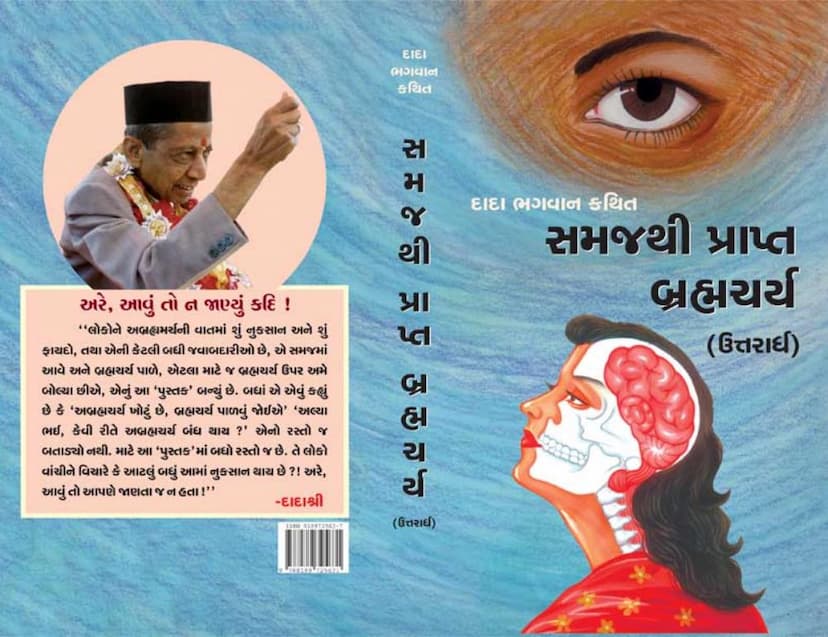Bhramcharya Uttaradh
Added to library: September 1, 2025

Summary
Here's a comprehensive summary of the Jain text "Bhramcharya Uttaradh" by Dada Bhagwan, based on the provided pages:
Overall Purpose and Core Message:
The book, "Bhramcharya Uttaradh" (Celibacy - The Latter Half), authored by Dada Bhagwan and published by Dada Bhagwan Foundation, aims to explain the true meaning and practice of celibacy (brahmacharya) through practical spiritual science (akram vignan). The central theme is that true celibacy is not about outward suppression of desires but about achieving a state of inner detachment and self-realization, even while living a worldly life. It emphasizes that knowledge (jnana) from a living Gnani Purush is the key to overcoming the deep-rooted attraction and delusions surrounding sensual desires and ultimately achieving liberation (moksha).
Key Concepts and Teachings:
- Celibacy is not about Suppression, but Awareness: Dada Bhagwan clarifies that the aim isn't to suppress desires, but to gain the right perspective through self-knowledge. The real "poison" is not the desires themselves but the fearlessness or recklessness (nidarta) in them. If one fears desires and feels regret for indulging in them, they can escape them. Recklessness, or the belief that "desires don't affect me," is the actual poison.
- The "Akram Vignyan" Path: This teaching offers a revolutionary approach where liberation and true celibacy are achievable even for householders living with their families. This is contrasted with the traditional path (kramik marg) which often required complete renunciation.
- Understanding the "Self" vs. the "Non-Self": A crucial aspect of the teaching is the distinction between the Self (Atma) and the non-Self (noneself). The Self is pure, unchanging, and the pure experiencer (jnata-drushta). The non-Self comprises the body, mind, speech, and the world. True celibacy involves recognizing the Self and remaining detached from the non-Self, even when interacting with it.
- The Power of Knowledge and Vision: The Gnani Purush's knowledge (jnana) transforms one's vision (drushti). Seeing the Self within everything, including women, helps overcome attraction. The "Shri Vision" can make the physical body appear as bones, flesh, and internal organs, thus dissolving sexual attraction.
- "My Fault" vs. "Your Fault": The blame for succumbing to desires lies not with the opposite sex but with one's own internal state and lack of self-awareness. The book stresses that it's "our fault" when our vision gets clouded.
- The Importance of Intention and Awareness: True celibacy is maintained through constant awareness and the right intention. Even if external circumstances are challenging, maintaining inner purity and the right understanding is paramount.
- The Dangers of "Fearlessness" and Misuse of Knowledge: The book warns against the misuse of knowledge, believing that once knowledge is attained, one can indulge recklessly. True knowledge leads to awareness and carefulness, not recklessness.
- The Five Pillars of Jainism and Celibacy: The text implies that celibacy is interconnected with the five vows (mahávratas) of Jainism. Indulging in illicit desires violates these vows.
- The True Nature of Pleasure: The text describes sensual pleasure as ultimately painful and comparable to scratching an itch – a temporary relief followed by increased suffering. True, lasting happiness comes from the Self.
- Celibacy in Householder Life: The book addresses married individuals, stating that celibacy can be maintained within marriage by adhering to specific principles and maintaining awareness. It's about not crossing boundaries and not allowing the mind to stray.
- The Role of the Gnani Purush: The Gnani Purush is presented as the guide who can reveal the secrets of celibacy and provide the scientific understanding needed to achieve it. Their presence and teachings are essential for true progress on the spiritual path.
- Celibacy as a Gradual Process: While the ultimate goal is complete celibacy, the path involves continuous effort, self-awareness, and practice. The Gnani Purush's guidance helps in this journey, offering tools like pratikraman (self-correction).
- Distinction Between Married and Unmarried Celibacy: While the ideal is complete celibacy, the text acknowledges that for married individuals, maintaining awareness and adherence to boundaries within their marriage is considered a form of celibacy in this era.
Key Sections and Themes:
- Chapter 1: Keys to Celibacy for Married People: This section focuses on householders and provides practical guidance on how to maintain celibacy amidst worldly life. It tackles common misconceptions and offers solutions based on Dada Bhagwan's spiritual science.
- Chapter 2: Celibacy through Self-Awareness: This part delves deeper into the spiritual aspects of celibacy, emphasizing the importance of self-awareness and the role of the Self in achieving this state.
Target Audience:
The book appears to be targeted at individuals seeking spiritual growth and liberation, particularly those who are married and find it challenging to adhere to traditional ascetic paths. It offers a path to self-realization without demanding outward renunciation.
Publisher and Context:
Published by Dada Bhagwan Foundation (Madras), the catalog link suggests it's part of a larger collection of spiritual texts. The publisher's emphasis on "Param Vinay" (Supreme Humility) and "I know nothing" reflects the lineage of spiritual teachings.
In essence, "Bhramcharya Uttaradh" aims to demystify celibacy, presenting it not as a harsh penance but as an achievable spiritual state through the grace of self-knowledge and the teachings of a Gnani Purush, even within the complexities of modern life.